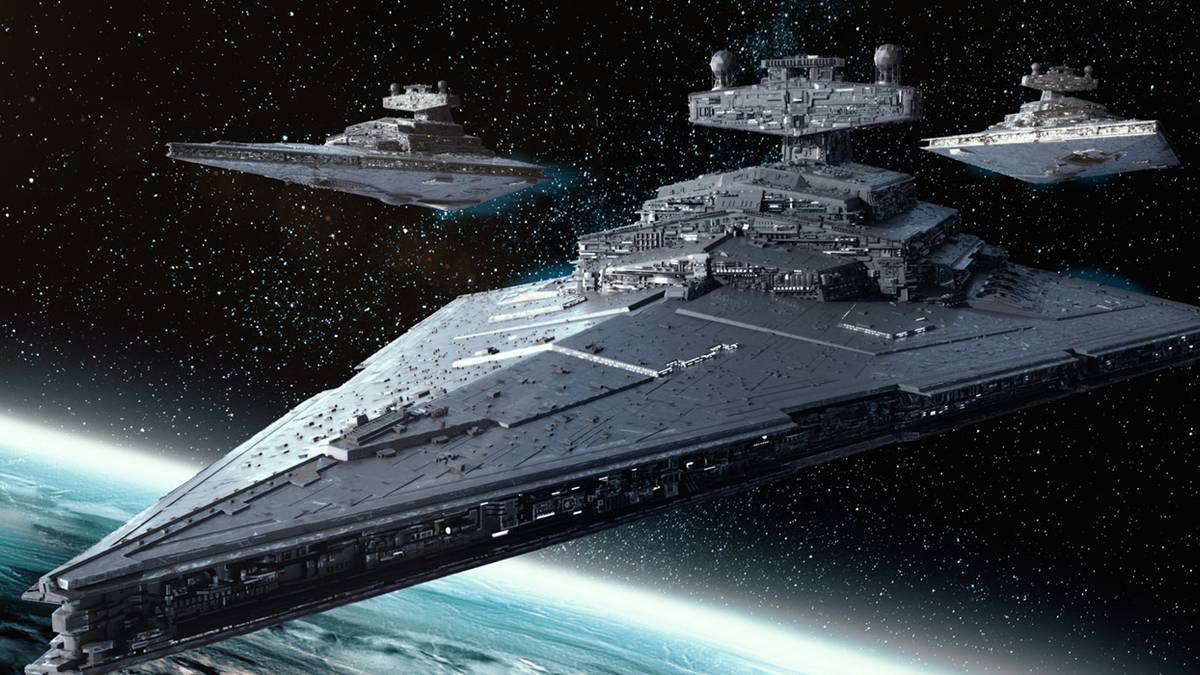The true power output of turbolasers in Star Wars is notoriously hard to pin down with precision. Canon and Legends sources often contradict each other, and cinematic depictions prioritize spectacle over physics.
But what we can do is establish lower bounds — the minimum energy required for a turbolaser to accomplish the feats we see on-screen. This doesn’t tell us the maximum power (which could be orders of magnitude higher), but it does give us a baseline: the absolute minimum firepower a turbolaser must deliver to achieve its destructive effects.
In other words: if we see a turbolaser blasting through armor plating, shattering asteroids, or punching holes into capital ships, we can calculate the minimum joules per shot needed. And trust me — even these conservative estimates are already ridiculous by real-world standards.
One of the best canonical benchmarks for turbolaser firepower comes from The Empire Strikes Back. During the asteroid field sequence, an Imperial Star Destroyer (ISD) is shown blasting asteroids out of its path with precise turbolaser shots.
This moment gives us a rare opportunity for semi-reliable energy scaling. Why? Because unlike starship armor or shield technology (which are fictional and vary wildly), asteroids are real objects we can model scientifically. Their size can be estimated from on-screen visuals.
The beams used in these scenes were mostly medium-sized turbolaser blasts, with occasional longer bolts visible. Importantly, the heavy dorsal turrets of the ISD were never fired, meaning the energy values we derive here are lower-limit estimates. In other words, the Star Destroyer wasn’t even using its heaviest guns — and still managed to vaporize asteroids with ease.
This makes the asteroid field sequence an excellent baseline test case for analyzing turbolaser firepower in a way that blends cinematic evidence with real-world physics.
Estimating the Asteroid Size
 |
| Star Destroyer I |
To determine the turbolaser’s order of magnitude we first need the size of the asteroid being destroyed. The camera angle makes precise measurement tricky, but we can make a reasonable estimate by using a visual scale reference: the Millennium Falcon, which has an official length of 34.75 meters. In the sequence the Falcon appears tiny next to most of the asteroids — many look similar or larger in size — so a clean, round estimate of ≈ 40 meters in diameter is sensible and defensible for our calculations.
With that diameter as our baseline, we can now estimate volume, mass, and from there compute the minimum energy required to melt/vaporize the Asteroid — which gives us a conservative lower bound on the turbolaser’s per-shot energy. Want me to run those numbers next?
Note that the asteroid struck by this large turbolaser bolt is seen melting and then vaporizing, and yet the bolt continues through it—keeps its shape and trajectory as if the Asteroid were nothing. That implies the energy contained in that single bolt far exceeds the minimum required to vaporize the asteroid. The beam even punches through and continues into another Asteroid downstream.
As for the asteroids’ chemical composition, Wayne Poe observes:
“More than 90% of the asteroids studied fall into one of two groups: stony-iron or carbonaceous. Only a few percent of meteorites found on Earth are carbonaceous — most museum specimens are stony-iron because the carbonaceous ones break up in the atmosphere or weather away more easily.
He goes on to say that the asteroids in The Empire Strikes Back appear rusty-red, which suggests a ferrous (iron-rich) composition.”
Using that ferrous assumption and our diameter estimate (≈ 40 m → volume ≈ 33,510 m³), the mass calculation is:
Assumed density (iron / ferrous rock): 7,800 kg/m³Mass:
33,510 m^3×7,800 kg/m^3 ≈ 2.61378e8 kg → ≈ 261,378,000 kg (≈ 2.61×10⁸ kg)next-step (energy to vaporize — conservative lower bound)
If you want a conservative lower bound, Energy for vaporisation of 1 kg of iron ≈ 7.6 megajoules
Energy to melt that mass: 2.61378e8*7.6MJ = 1.9864728e15 Joules
→ ≈ 450 Kilotons of TNT
So: a single 40 m iron asteroid would require on the order of 10^15 joules to vaporize.
Remember: the beam continues intact after piercing, which implies the actual energy in the bolt is significantly higher than this lower bound.
Conclusion: Turbolasers, Physics, and Galactic Overkill
From a single scene in The Empire Strikes Back, we can anchor the firepower of Star Wars turbolasers to real-world physics. Even using the most conservative assumptions — a 40-meter iron asteroid and only the energy needed to melt it — we end up with a figure of ~1.9e15 joules, or about 450 kilotons of TNT per shot. And that’s just a lower bound.
In reality, the beams vaporize the Asteroid, and then keep traveling unimpeded, which means their true energy output is far higher. If a medium turbolaser blast scales to hundreds of kilotons per shot, then the heavy dorsal batteries of an Imperial Star Destroyer would sit firmly in the multi-megaton (or greater) range.
In short: turbolasers are not just flashy sci-fi weapons — they’re weapons of absurd, physics-breaking power, casually swatting away asteroids with the kind of energy humans currently associate with nuclear arsenals. Star Wars doesn’t just look cinematic — by scientific standards, it’s showcasing energy levels that make nukes look like fireworks.








0 Comments